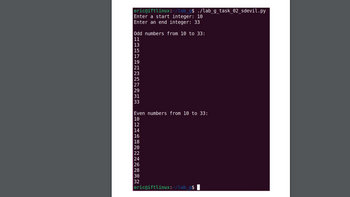
Concept explainers
Write the following Python script
1. Your program should ask the user to input two integer numbers: start (S) and end (E).
The range of numbers will be from S to E (inclusive).
2. The program should first print all the odd numbers from S to E, each on a new line.
3. Next, the program should print all the even numbers from S to E, each on a new line.
4. If a user enters something that's not an integer number for S or E, your program should
handle this exception and print a warning message: "Invalid input, please enter integer
numbers only".
Here is a screenshot of the expected behavior, testing all scenarios described above. Replicate
this functionality in your script, including the formatting and outputs of all messages. The
program must work for any starting or ending integer values that the user enters.

Trending nowThis is a popular solution!
Step by stepSolved in 3 steps with 1 images

- In Mathematics, a prime number is a natural number greater than 1 that has no positive divisors other than 1 and itself. In simpler terms, a prime number is only divisible by 1 and the number itself without leaving any remainder. For example: 2, 3, 5, 7 are prime numbers. 4, 6, 8, 9 are not prime numbers. Write an assembly program that prompts the user to input a number [0-9] and checks whether it is a prime number or not. The program should display a message indicating whether the entered number is a prime number or not.arrow_forwardpythonarrow_forward3. Having a secure password is a very important practice, when much of our information is stored online. Write a program that validates a new password, following these rules: The password must be at least 8 characters long. The password must have at least one uppercase and one lowercase letter. The password must have at least one digit. Write a program that asks for a password, then asks again to confirm it. If the passwords don't match or the rules are not fulfilled, prompt again. Your program should include a function that checks whether a password is valid.arrow_forward
 Database System ConceptsComputer ScienceISBN:9780078022159Author:Abraham Silberschatz Professor, Henry F. Korth, S. SudarshanPublisher:McGraw-Hill Education
Database System ConceptsComputer ScienceISBN:9780078022159Author:Abraham Silberschatz Professor, Henry F. Korth, S. SudarshanPublisher:McGraw-Hill Education Starting Out with Python (4th Edition)Computer ScienceISBN:9780134444321Author:Tony GaddisPublisher:PEARSON
Starting Out with Python (4th Edition)Computer ScienceISBN:9780134444321Author:Tony GaddisPublisher:PEARSON Digital Fundamentals (11th Edition)Computer ScienceISBN:9780132737968Author:Thomas L. FloydPublisher:PEARSON
Digital Fundamentals (11th Edition)Computer ScienceISBN:9780132737968Author:Thomas L. FloydPublisher:PEARSON C How to Program (8th Edition)Computer ScienceISBN:9780133976892Author:Paul J. Deitel, Harvey DeitelPublisher:PEARSON
C How to Program (8th Edition)Computer ScienceISBN:9780133976892Author:Paul J. Deitel, Harvey DeitelPublisher:PEARSON Database Systems: Design, Implementation, & Manag...Computer ScienceISBN:9781337627900Author:Carlos Coronel, Steven MorrisPublisher:Cengage Learning
Database Systems: Design, Implementation, & Manag...Computer ScienceISBN:9781337627900Author:Carlos Coronel, Steven MorrisPublisher:Cengage Learning Programmable Logic ControllersComputer ScienceISBN:9780073373843Author:Frank D. PetruzellaPublisher:McGraw-Hill Education
Programmable Logic ControllersComputer ScienceISBN:9780073373843Author:Frank D. PetruzellaPublisher:McGraw-Hill Education





